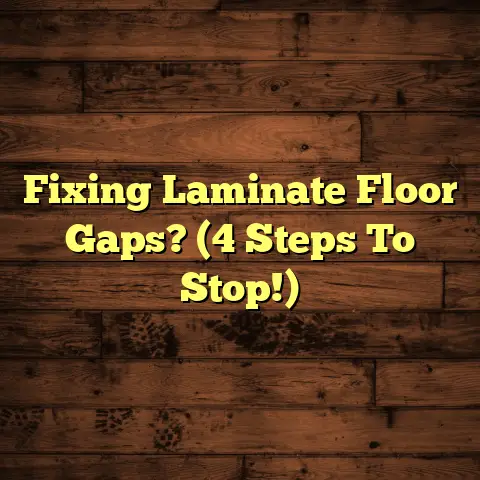Unsealed Wood Floors Look? (2 Signs Rot!)
I’ve seen it all when it comes to wood floors – the good, the bad, and the downright ugly. And let me tell you, a beautiful wood floor can truly transform a space. It adds warmth, character, and a touch of elegance that’s hard to beat.
Think about it: that rich, inviting glow, the satisfying thunk underfoot, and the way it ties the whole room together. Plus, a well-maintained wood floor can seriously boost your property value. It’s an investment, plain and simple.
But here’s the thing: like any investment, it needs protection. That’s where sealing comes in. Neglecting to seal your wood floors is like leaving your car out in a hailstorm – eventually, you’re going to pay the price.
In this article, I’m going to break down everything you need to know about unsealed wood floors and the telltale signs of rot. We’ll cover what unsealed floors actually are, why sealing is so important, and how to spot those dreaded rot indicators.
Ready to dive in? Let’s get started!
Section 1: Understanding Unsealed Wood Floors
What Are Unsealed Wood Floors?
Alright, so what exactly are unsealed wood floors? Simply put, they’re wood floors that haven’t been treated with a sealant. Sealing is the process of applying a protective coating to the wood that acts as a barrier against moisture, dirt, and everyday wear and tear.
Think of it like this: sealing is like applying sunscreen to your skin. It shields the wood from the elements, preventing damage and prolonging its life.
Now, there are a few different types of wood flooring that are commonly left unsealed. One example is unfinished hardwood. This is exactly what it sounds like – hardwood flooring that’s installed in its raw state and requires sanding and finishing on-site.
Another type is reclaimed wood. This wood, often sourced from old barns or factories, has a unique character and history, but it may not always be properly sealed. Why? Well, some homeowners want to preserve its natural, rustic look.
But here’s the catch: leaving wood unsealed can open the door to a whole host of problems.
Visual Characteristics of Unsealed Wood Floors
So, how can you tell if your wood floors are unsealed? Well, one of the most obvious signs is the appearance of the wood itself. Unsealed wood tends to look duller and more porous than sealed wood.
It might also have a rougher texture. Sealed wood, on the other hand, usually has a smooth, glossy finish.
Another telltale sign is how the wood reacts to moisture. Unsealed wood is much more absorbent than sealed wood. If you spill water on an unsealed floor, you’ll likely see it soak in quickly, potentially leading to discoloration or staining.
Have you ever noticed dark spots or rings on your wood floor? That’s often a sign of moisture damage in unsealed areas. I’ve seen floors where every spill leaves a permanent mark – it’s not a pretty sight!
Common Areas for Unsealed Wood Floors
Where are you most likely to find unsealed wood floors? Well, basements, attics, and workshops are common culprits. These areas are often more prone to moisture and temperature fluctuations, which can make sealing a challenge.
Some homeowners might also choose not to seal wood floors in these areas to save money or because they simply don’t prioritize these spaces. I’ve even encountered situations where homeowners intentionally left wood unsealed in a rustic-themed room to enhance the aesthetic.
But trust me, the long-term consequences can outweigh any short-term benefits.
Section 2: The Importance of Sealing Wood Floors
Protective Benefits of Sealing
Okay, so we’ve established what unsealed wood floors are. Now, let’s talk about why sealing is so crucial. As I mentioned earlier, sealing acts as a protective barrier against all sorts of threats to your wood floors.
First and foremost, it protects against moisture. Wood is a porous material, which means it readily absorbs water. This can lead to swelling, warping, and eventually, rot. Sealants create a waterproof barrier that prevents moisture from penetrating the wood.
Sealing also protects against dirt and grime. Unsealed wood is like a magnet for dirt, which can grind into the surface and cause scratches and wear. A sealant creates a smooth, easy-to-clean surface that repels dirt and debris.
And let’s not forget about wear and tear! Everyday foot traffic can take a toll on your wood floors, leading to scratches, dents, and a general dulling of the finish. Sealants provide a durable layer of protection that helps to resist these types of damage.
But perhaps the most important benefit of sealing is its ability to prevent rot, mold, and mildew. These nasty organisms thrive in moist environments, and unsealed wood provides the perfect breeding ground. Sealants create a hostile environment for these organisms, inhibiting their growth and preventing them from causing serious damage.
Long-term Implications of Neglecting to Seal
So, what happens if you neglect to seal your wood floors? Well, the consequences can be pretty significant, both financially and aesthetically.
For starters, you’re looking at increased repair costs. Moisture damage, rot, and wear and tear can all lead to costly repairs down the line. I’ve seen cases where homeowners had to replace entire sections of their wood floors because they failed to seal them properly.
And let’s not forget about the impact on your property value. Damaged or poorly maintained wood floors can detract from the overall appeal of your home and decrease its value. A recent study by the National Association of Realtors found that homes with well-maintained hardwood floors sold for an average of 2.5% more than homes with other types of flooring.
That’s a significant difference!
But the financial implications aren’t the only thing to consider. Unsealed wood floors can also pose a health risk. Mold and mildew can trigger allergies and respiratory problems, especially in people with sensitivities.
According to the Environmental Protection Agency (EPA), indoor mold growth should be addressed promptly to prevent health problems. So, neglecting to seal your wood floors isn’t just a cosmetic issue – it can actually impact your health.
Section 3: Signs of Rot in Unsealed Wood Floors
Alright, let’s get down to the nitty-gritty. How do you know if your unsealed wood floors are starting to rot? Well, there are a few key signs to look out for.
Sign 1: Visible Fungal Growth
One of the most obvious signs of rot is visible fungal growth. This can take many forms, including mold, mildew, and other types of fungi. Mold and mildew often appear as fuzzy or powdery patches on the surface of the wood.
They can be black, green, white, or even orange in color. Other types of fungi might look like small mushrooms or other growths sprouting from the wood.
Fungal growth thrives in moist, dark environments with poor ventilation. If you notice fungal growth on your wood floors, it’s a clear indication that moisture is present and that rot is likely occurring.
I’ve seen cases where entire sections of wood floors were covered in mold because of a leaky pipe or poor ventilation. It’s not a pleasant sight, and it can be a serious health hazard.
Here’s a quick guide to identifying common types of fungal growth:
| Type of Fungus | Appearance | Common Locations | Health Concerns |
|---|---|---|---|
| Mold | Fuzzy or slimy patches; various colors | Damp areas, basements, bathrooms | Allergies, respiratory problems, skin irritation |
| Mildew | Powdery or fluffy; white, gray, or black | Surfaces exposed to moisture, bathrooms, kitchens | Allergies, respiratory irritation |
| Wood Rot Fungi | Visible growths, discoloration, soft spots | Areas with prolonged moisture exposure | Structural damage, decay |
Remember, if you suspect fungal growth, it’s important to address it promptly.
Sign 2: Soft or Spongy Spots
Another telltale sign of rot is soft or spongy spots in the wood. These spots indicate that the wood fibers have been weakened and broken down by moisture and fungi.
To identify these areas, start by visually inspecting your wood floors. Look for areas that appear discolored or sunken. Then, gently press on these areas with your finger. If the wood feels soft or spongy, it’s likely that rot is present.
You might also notice that the wood crumbles or flakes easily in these areas. The underlying cause of these soft spots is moisture damage. When wood absorbs moisture, it becomes more susceptible to fungal growth.
The fungi then break down the wood fibers, causing them to weaken and soften. Over time, this process can lead to significant structural damage.
I remember one case where a homeowner noticed a small soft spot near their front door. They ignored it for months, thinking it was just a minor issue. But when I finally came to inspect it, I discovered that the rot had spread extensively underneath the floorboards. The entire section of flooring had to be replaced.
Case Studies
Let’s take a look at some real-life examples of homeowners who neglected sealing their wood floors, leading to rot.
Case Study 1: The Basement Disaster
A homeowner in [City, State] decided to install unfinished hardwood flooring in their basement. They liked the natural look of the wood and decided not to seal it. Over time, the basement became damp and humid, creating the perfect environment for mold and mildew.
Within a few years, the wood floors were covered in fungal growth and had developed soft, spongy spots. The homeowner had to spend thousands of dollars to remove the damaged flooring and replace it with a moisture-resistant material.
Before: Image of mold-covered wood floor in a basement.
After: Image of the basement floor after replacement with tile or concrete.
Testimonial: “I wish I had known the importance of sealing my wood floors. It would have saved me a lot of money and headaches.” – [Homeowner’s Name]
Case Study 2: The Kitchen Catastrophe
A homeowner in [City, State] installed reclaimed wood flooring in their kitchen. They loved the rustic look of the wood, but they didn’t seal it properly. Over time, spills and splashes from cooking and cleaning soaked into the wood, causing it to warp and rot.
The homeowner also noticed a musty odor in the kitchen, which was a sign of mold growth. Eventually, they had to replace the entire kitchen floor due to extensive water damage.
Before: Image of warped and stained wood floor in a kitchen.
After: Image of the kitchen floor after replacement with new, sealed wood or tile.
Testimonial: “I learned the hard way that sealing your wood floors is essential, especially in high-moisture areas like the kitchen.” – [Homeowner’s Name]
These case studies highlight the importance of sealing wood floors and the potential consequences of neglecting this essential maintenance step.
Section 4: Conclusion
Alright, we’ve covered a lot of ground in this article. We’ve talked about what unsealed wood floors are, why sealing is so important, and how to spot the signs of rot.
Let’s recap the key takeaways:
- Unsealed wood floors are vulnerable to moisture, dirt, and wear and tear.
- Sealing protects your wood floors from rot, mold, and mildew.
- Neglecting to seal your wood floors can lead to costly repairs and decreased property value.
- Visible fungal growth and soft or spongy spots are telltale signs of rot.
I hope this article has shed some light on the importance of sealing your wood floors. It’s a simple step that can save you a lot of money and headaches in the long run.
Remember, your wood floors are an investment. Taking care of them will not only enhance the beauty of your home but also protect your financial well-being.
So, if you have unsealed wood floors, I urge you to take action today. Seal them properly and protect them from the elements. Your floors (and your wallet) will thank you for it!
And if you’re unsure about how to seal your wood floors yourself, don’t hesitate to call a professional. A qualified flooring contractor can assess your needs and recommend the best sealing solution for your situation.
Thanks for reading, and happy flooring!





